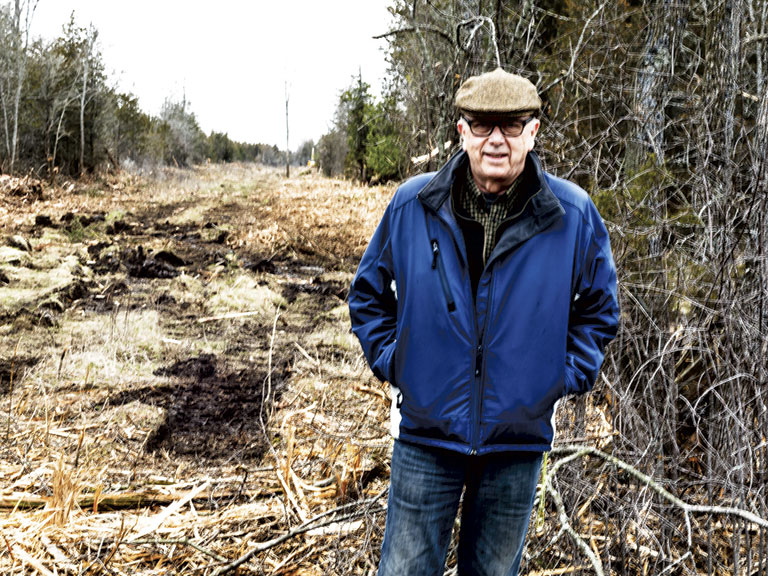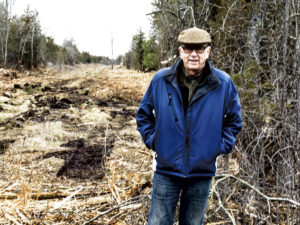County News
No protection

Developer resumes clear cutting in South Marysburgh
The south shore of Prince Edward County is its hidden attraction. Far from the hip restaurants and craft breweries that are drawing tourists to the County, the peaceful, lush tracts of land, some of which have been turned into nature reserves or designated wildlife areas, can remind an occasional visitor of the true beauty of the County.
Of course, driving the roads at the south end of South Marysburgh means driving carefully, especially in the spring. It’s easy to see life emerges quickly here, with explosions of green everywhere, but birds, rabbits, snakes and turtles are also flying low, darting and slithering out and plodding along, carefree on roads cars seldom traverse, appreciating the open space.
But a visit to the south shore last week might have brought with it more than the sounds of soft rain and cheerful chirping.
On two properties owned by wpd Canada Corporation, the company in charge of the White Pines wind project, machines could be heard on the marshy land, cutting away at vegetation to build a private road.
In July 2015, the Ministry of Environment and Climate Change (MOECC) approved a 27- turbine project on the lands that straddle South Marysburgh and Athol. But that has been on hold as the approval is held up in court.

Orville Walsh heads the Alliance to Protect Prince Edward County. He stands before a newly barren swathe of land on Royal Road, one of several spots that has seen clear-cutting over the past week.
The company says it is clearing a portion of its land that is not in dispute. But the Alliance to Protect Prince Edward County (APPEC), and naturalist groups argue that an Environmental Review Tribunal has determined that the project poses a serious and irreversible threat to the Blanding’s turtle and the little brown bat. They argue that until the Tribunal rules on whether to accept the company’s proposed measures to limit harm to these species, any work done on this land poses an untenable risk.
From the road, the work looks dramatic. A 17-metre-wide strip of land beside a road concession has been clear-cut, with fresh, crudely torn bases of trees and shrubs newly exposed. The wide, mucky road goes off into the distance. It’s impossible to tell, without trespassing, whether the company has stuck to the land that is not in dispute.
For Orville Welsh, a member of APPEC who has been following the dispute closely, there are several issues with this work.
For one, the clearance is wider than what the company promised—five to six metres. For another, it is being done at a time when animals are up and moving around.
“What they’re doing now is they’re clearing areas they could’ve cleared all along, basically. Since last year, with some restrictions during the spring and early summer… they could’ve done it over the winter,” says Walsh. “Our concern is that they’re destroying habitat.”
Walsh, and APPEC, say they are concerned about the protected species that become active during the south shore spring, and especially the little brown bat and the Blanding’s turtle. These are the species at the forefront of APPEC’s ERT case against wpd, a case that has continued on since 2015.
There is also very little incentive to investigate whether wpd is following the rules, and to ensure they will continue to do so.
“There is nobody to enforce these things,” says Walsh. “And after a while, people stop complaining, because there’s no enforcement. The municipality would enforce it if it had to do with permits.”
Walsh related a story from a community that saw turbines built where promises the company made about clean-up of the site—to return it to its natural state— were broken. Those communities had no recourse, he said.
The wpd project includes a promise to remove paving from side roads, which today are mud and stone paths, full of ruts and puddles, barely driveable by any but the most hardy vehicles. The company would have to pave the roads in order to bring the large turbine equipment to the site, roads turtles—including the Blanding’s turtle—use to nest and sun themselves.
Walsh worries that the paving won’t be removed, and that beyond the life of the build, if the ERT approves it, the roads will encourage more traffic to the County’s hidden gem, making the problem even worse.

Comments (0)